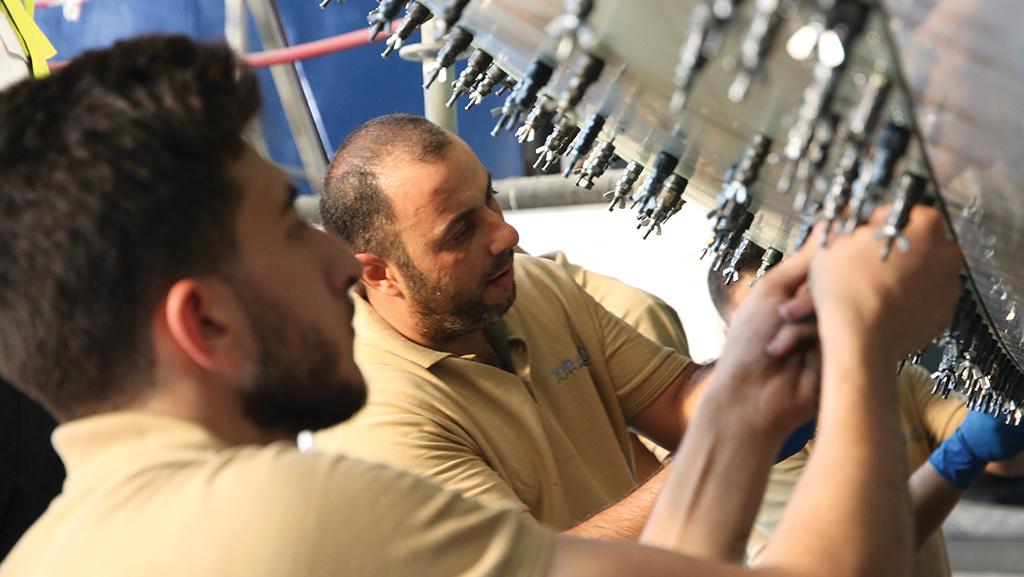
Independent, third-party MRO providers in the Middle East are operating at or near full capacity.
The aviation industry is experiencing dynamic changes that are dramatically affecting the cost and supply of MRO materials, and the Middle East is no exception to this trend. The material supply chain has seen considerable cost inflation post-pandemic, and as analysts at Alton Aviation suggest, demand for MRO services exceeds supply in the region.
In Europe, some MRO providers have seen a roughly 20% increase in material costs over the last three years. The situation in the Middle East is similar.
Most airlines in the region—such as Etihad Airways, Emirates, Qatar Airways and Saudia—have avoided the outsourcing trend for airframe heavy maintenance and maintained in-house capabilities. The limited number of independent third-party MRO suppliers in the Middle East, such as Joramco for airframe heavy maintvenance and Sanad Aerotech for engine MRO, are operating at nearly full capacity.
“The current climate presents a unique challenge in maintaining balance between airframe and engine materials supply and demand,” says Sultan Alaraj, CEO of Jordan-based Petra Aerospace, which provides asset management services, including airframe material sales and aircraft parts. “As airlines and MROs stage a cautious comeback, it is a delicate juggling act. Some materials remain in abundance due to reduced operations, while others are in short supply due to global disruptions, but achieving stability in this dynamic landscape is our paramount goal.”
Compared with the material cost surge for European MROs, Alaraj argues that MRO shops in the Middle East have managed a more controlled increase. “This region’s strategy involves diversifying our supplier base and collaborative efforts with neighboring regions to further boost the resilience of our supply chain,” he notes. “However, we are affected by the repair cost from the vendors due to increases in raw materials.”
Abu Dhabi-based Sanad is tackling these challenges head-on and staying vigilant about material costs. Managing Director and Group CEO Mansoor Janahi says creating strong relationships with suppliers is imperative. “By actively managing our supply chain, diversifying our options and forging strategic partnerships, we can better address cost fluctuations and ensure a consistent supply of materials,” he says.
Sanad is also closely monitoring emerging technologies, innovations and regulatory developments. “This foresight enables us to anticipate future trends and adjust our sourcing strategies,” Janahi says.
Lengthy turnaround times (TAT) are an ongoing industry conundrum as well. To address this, Janahi says Sanad is relying on strong relationships with dependable suppliers that understand the criticality of timely deliveries. “Additionally, we take a proactive approach by maintaining backup inventories of essential materials, ensuring a continuous supply flow even during unforeseen disruptions,” he adds.
Sanad is keeping a close eye on supply chain activities, which Janahi says enables it to identify and address any potential bottlenecks or disruptions well in advance. This proactive monitoring allows Sanad to respond swiftly and effectively, mitigating potential delays and keeping TATs on track, he notes.
In Dubai, Aeras Aviation is seeing CFM International CFM56 engine shop visit numbers at very healthy levels and a continued rise in used serviceable material (USM) demand, but it is also hearing buzz around the International Aero Engines V2500 market finally coming back to full strength.
“Our position in the market has changed in the last two years from parts trader to asset management company, where we now pivot between customers in the aftermarket, MRO network and the airline and lessor community, providing serviced solutions and USM support,” explains Aran Tindall, Aeras Aviation’s director of asset trading and engine programs.
During the pandemic, Aeras Aviation focused on the widebody and freighter market, offering airlines and MROs USM and sourcing of parts and engines across the Pratt & Whitney PW2000 and PW4000 and GE CF6-80C2 and -80E platforms that were in short supply. “This has grown from piece parts to whole-asset teardown to support our ever-growing network,” Tindall says.
However, Aeras’ core business activity revolves around the CFM56 and the V2500 families, and Tindall says it plans to grow into 2024 with increased engine teardowns and strategic package purchasing to support customer programs.
“Our engine teardown business has forged partnerships with teardown facilities and allowed us to negotiate favorable programs, pricing and TAT with both customers and repair vendors, while giving us up-to-date market data to help plan and strategize our next moves,” Tindall says.
With the increase in material prices across the board, Tindall says customers are searching for the most cost-effective solutions for their engines through USM, and Aeras is focused on keeping pricing as low as possible. This is increasingly difficult due to rising material and repair costs in the MRO and vendor network, coupled with material shortages that are naturally driving prices upward, he says. Tindall is confident that leveraging those relationships and contracts could ensure better repair pricing and any savings could be passed on to customers.
Some industry experts suggest Airbus A319 and A320 teardowns will decline next year, potentially affecting CFM56-5B material supply. However, Tindall does not expect that to be an issue, at least for material supply, for the next 18-24 months. “With the forecasted CFM56-5B shop-visit numbers still being lower than expected, the number of -5B engines coming to market now and projected for next year should be sufficient to service a good portion of those visits,” he says.
Tindall anticipates that tech insertion—inserting new technology into existing parts—and higher standard part numbers will be more difficult to source, but he notes that this is not a new problem for the aftermarket. “Market conditions are ever-changing, and we will continue to assess trends,” he says. “We are a smaller company, so this allows us to be fluid to these bumps in the road and change direction to suit quickly and ahead of some of our larger competitors.”
Tindall sees the more pressing issue as repair network TATs. “This will be the main driver of material supply issues over the next couple of years until we hopefully see some stabilization or new MRO vendors, increased capabilities and workforce being introduced to help the flow of parts through the process,” he says.

Back in Jordan, the conversation at Petra Aerospace is moving toward embracing cost-effective alternatives. Alaraj notices that airlines and MROs in the region, especially those focused on classic fleets, are increasingly open to solutions such as USM, designated engineering representative (DER) repairs and parts manufacturer approval (PMA) parts.
The Middle East has seen a significant appetite for innovative technologies such as real-time data analytics. Looking ahead, aftermarket players will be keen to explore new technologies that are better able to predict price fluctuations and help lower costs in the supply chain.
Alaraj acknowledges that real-time data analytics, for example, is spearheading efforts to lower MRO costs. By optimizing maintenance schedules, predicting equipment failures and reducing downtime, these technologies are poised to cut operational expenses markedly, he says. Breakthroughs such as 3D printing and advanced materials also hold immense promise in making repairs and parts manufacturing more cost-effective.



